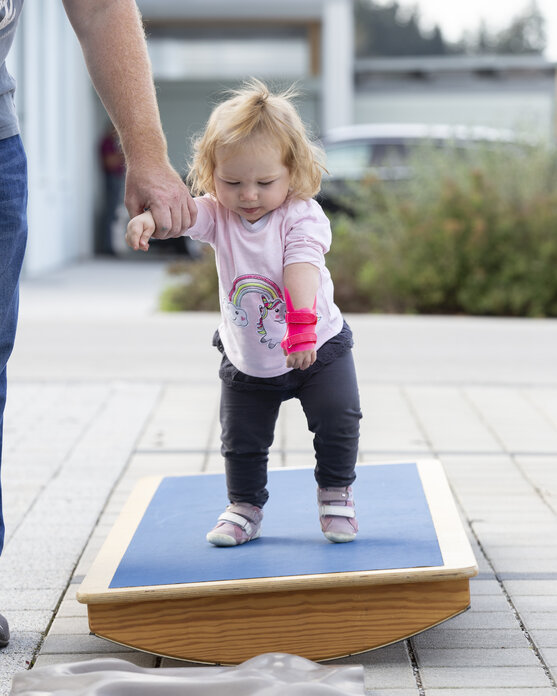We will make you an orthosis that is highly functional and visually a real eye-catcher!
Check out our YouTube channel for compelling stories about AMC patients.
Stiff joints since birth
What exactly is AMC?

Arthrogryphosis multiplex congenita, or AMC for short, is a condition characterized by multiple congenital joint contractures that lead to varying levels of immobility in the spine and extremities.
AMC is not curable. However, it is not progressive. Nevertheless, as the child grows, the contractures can lead to a variety of deformities and functional limitations in movement.
AMC occurs in about one out of 3,000-5,000 live births. The exact cause of AMC is unknown but impaired muscle development in utero and lack of fetal movement appear to be the leading causes. In some cases, AMC is inherited however most incidences occur without a predisposing genetic link.

The symptoms of AMC are variable and often complex. Furthermore, the extent of contractures and joint malalignments caused by AMC can vary significantly. In most cases, the joints in both the arms and legs are affected. However, in a small proportion of cases, only the arms or only the legs are affected. The contractures caused by AMC result in stiff joints. The degree of stiffness will differ from patient to patient.
Contractures can also occur in the wrist, fingers, and ankles which can lead to significant restrictions in movement. One common feature of AMC is pronounced flexion contractures in the wrists, finger joints, and thumb. Scoliosis of the spine may also occur.
AMC may also cause organ and nervous system malformations which could possibly lead to paralysis.
Treatment with orthoses
Constant loads on poorly aligned joints can lead to premature joint wear and tear and cause long term damage. As such, any malalignments should be treated as early as possible. In addition to surgical interventions, many joint malalignments can also be corrected with orthoses. Joint mobility can often be improved through therapy that is targeted at early mobilization and accompanied by dynamic orthotic care. The time at which the treatment is started is critical for successful conservative therapy – therapeutic measures should already be underway during the first few months of life.
In babies, orthotic care should begin around the age of three or four months. Radiological findings and close collaboration with the attending physicians and therapists are essential to providing optimal orthotic care that is individualized to each patient.
Due to the complex characteristics of AMC, orthoses are individually designed and manufactured to fit the patient’s needs.

World trip with AMC
Around the world with arthrogryposis - is that possible??
Alex and Lovis will soon start their biggest adventure so far: A 12-month world trip through 6 continents! However, Alex has been living with arthrogryposis multiplex congenita since birth and is therefore dependent on the physical support of his buddy Lovis.
Their mission during the trip: to stand up for an inclusive world, to draw attention to the topic of disability and to show what is possible despite a physical limitation.
Briefly explained
Your questions about Arthrogryposis
Arthrogryposis can be caused by genetic and environmental factors. However, AMC usually occurs spontaneously without heredity.
There is no cure for AMC (arthrogryposis multiplex congenita). However, congenital joint stiffness cannot worsen over time. Early treatment (orthotics, physical therapy, etc.) can allow people who have AMC to live relatively independently.
The life expectancy of a person suffering from AMC is not limited as long as only the extremities (arms and/or legs) are affected and the organs are not damaged.
The clinical picture of arthrogryposis multiplex congenita (AMC) is very variable. Signs of AMC are mostly contractures of the joints in flexion or extension position with simultaneous muscle atrophy (underdeveloped, powerless muscles). A clear indication of arthrogryposis is the absence of skin folds on the flexor side of the joints. In contrast, small dimples form on the extensor side. The arms and legs of a person suffering from AMC can sometimes appear stuffed.
Children and adults suffering from AMC often have to deal with movement restrictions. Many of those affected cannot move independently due to joint stiffness in the legs and are dependent on an (electric) wheelchair. The insufficient mobility in the arms presents AMC patients with many everyday problems. With stiffened elbow and wrist joints, persons with arthrogryposis are unable, for example, to bring their own hand to their mouth when eating. Also, reaching for and operating equipment or writing is often difficult for those affected because they cannot make a fist.
The good news is that many malpositions can be corrected with orthoses. In combination with physiotherapy and rehabilitation aids, they can often achieve amazing results for AMC patients.
The majority of children suffering from arthrogryposis do not have an intellectual disability. On the contrary, many AMC patients concentrate on their mental abilities due to their physical limitation and develop cognitively very well.
All-round care!
We have the solution
AMC often causes stiffness in the wrist, finger, and thumb joints. In addition, some patients may experience stiffening of the ankle, knee, and hip joints all of which can restrict movement. These misaligned joints can be corrected with orthoses.
Our orthopedic devices are important components of the medical and therapeutic treatment concept. Amazing results for AMC patients can be achieved in combination with physiotherapy and rehabilitation aids.


Let yourself be inspired! We follow many interesting patients during their Pohlig appointment and give you personal insights.

For those who want to delve even deeper into the subject, we have a suitable video for almost every area of treatment!

Take a look behind the scenes at Pohlig and learn about different health conditions and our innovative assistive technology solutions!

Sometimes funny, sometimes explanatory, sometimes emotional - but above all always entertaining: our videos on TikTok!
Celine shows them all
Sports with AMC?
– No problem!
AMC: this is what Celine has been suffering from since birth. Despite her congenital joint stiffness, Celine wants to try out everything she feels like doing. She is currently applying for an apprenticeship as an industrial management assistant. She spends her free time with her best friend Marla. Chilling by the lake, eating ice cream... activities that people do when they have some spare time. Her disability hardly plays a role in her daily activities...
What a great team! Robin (8) has AMC, leaving his movement severely restricted. For more than a year, he has been training with the Labrador retriever, Chester, who reliably helps Robin get on better with everyday life.
The Orthopedic Children’s Clinic in Aschau is one of the largest specialist clinics for pediatric orthopedics in Central Europe.
When it comes to orthopedic treatment for infants and children, it is extremely important for all parties to pull together: parents, doctors, technicians and therapists.
Physiotherapists accompany the individual treatment of our AMC patients at our headquarters and several POHLIG branches.




